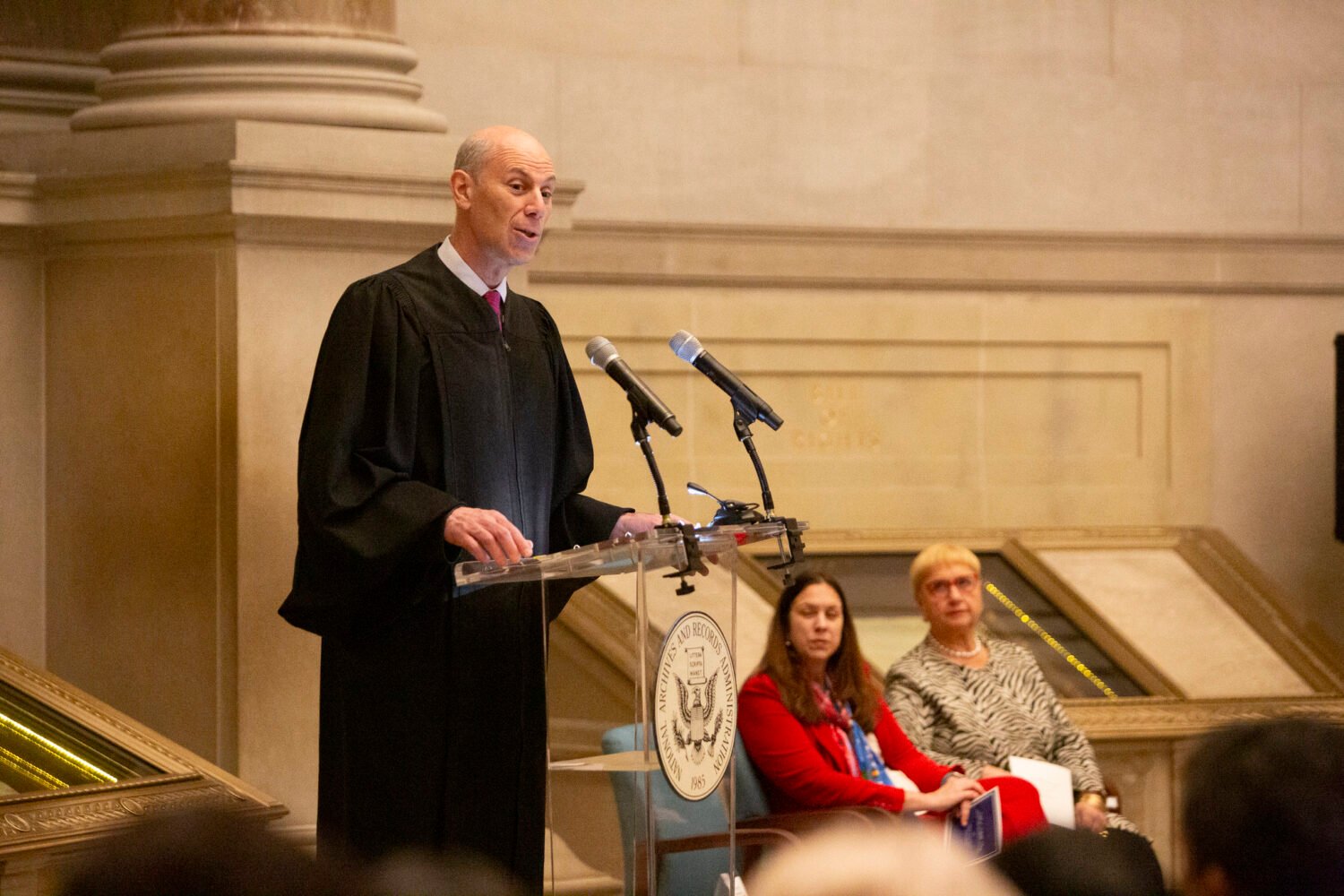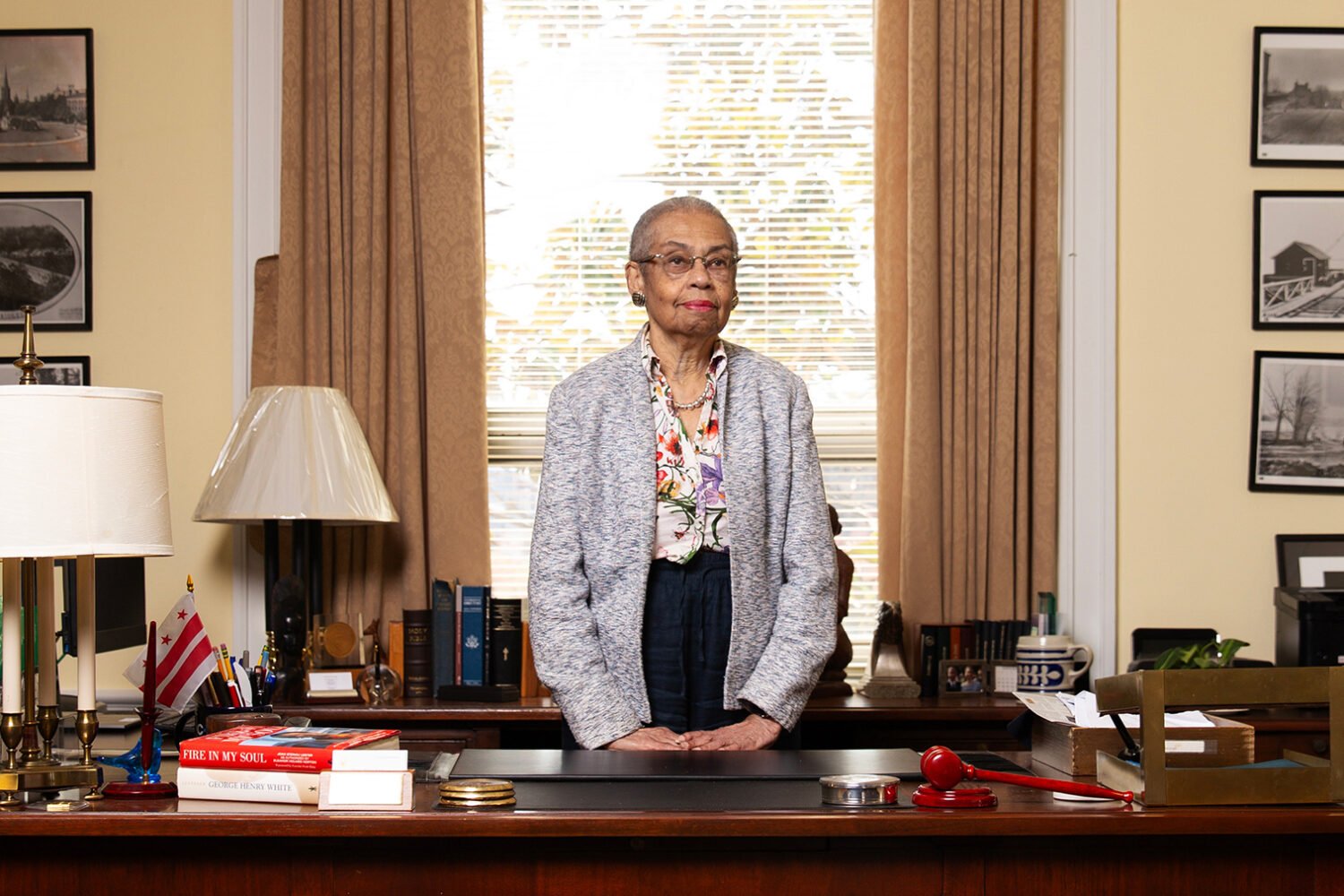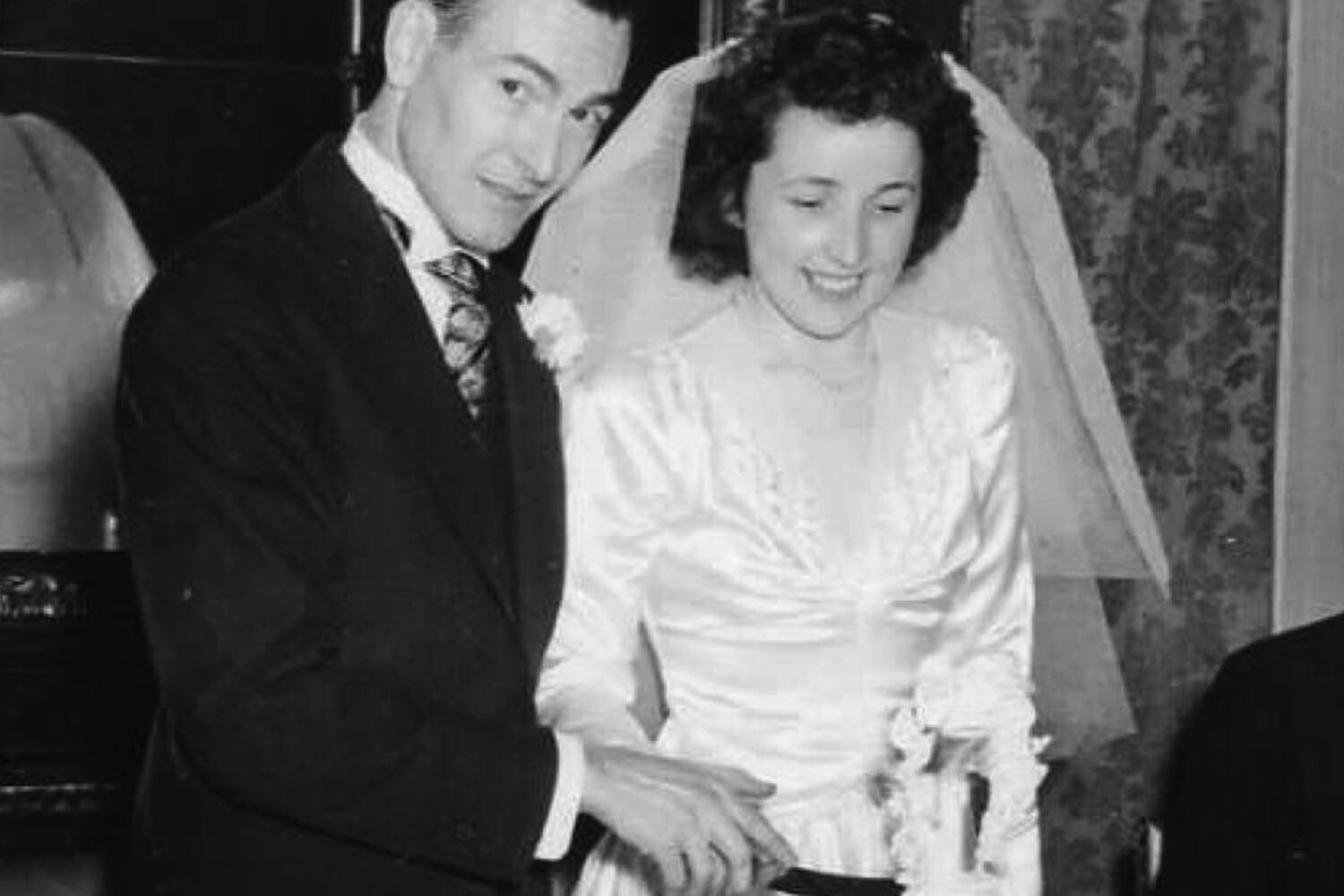Gazing out across the Chesapeake Bay from their sleek 37-foot yacht, Helene, in the summer of 2007, Kendall and Gwen Myers appeared to be blissfully carefree. They’d been together more than three decades, but they delighted in ensuring that their world was composed principally of each other.
“It is 8 pm here; we are having a drink and are practically melting in our chairs while repeating to one another, ‘We have the most beautiful boat,’ ” Gwen wrote in a message to the yacht’s Swedish makers.
The previous year, they’d traveled to Kungsviken, where ships had been built for Scandinavian royalty for 950 years, to see their teak-decked Malo 37 Classic being built. The Malo 37 was the 2009 Import Boat of the Year at the Annapolis Boat Show, where Helene, with a custom-crafted mahogany interior, was on display. It had cost the couple some $350,000.
“Today the temperature was around 60 degrees and the wind from 4 to 8 knots,” Gwen continued. “We sailed the good ship Helene on the Bay for 4 hours. Kendall sailed then napped for an hour on a pad behind the helm’s seat. I used a finger to occasionally touch the wheel while the boat sailed herself. Clouds were mesmerizing. No other boats around, so thoroughly relaxed.”
Kendall was six-foot-six and slightly stooped, with receding white hair, a mustache, and a blueblood WASP lineage—giving him the ruffled, patrician air of an Oxbridge don. About to retire from the State Department, he also was an adjunct professor of international relations at DC’s School of Advanced International Studies (SAIS), part of Johns Hopkins University and where he had been awarded his PhD.
Gwen, a diminutive former Democratic aide on Capitol Hill with sun-streaked hair and seldom any makeup, had worked for Riggs Bank and part-time at an independent bookstore in Cleveland Park. Now the couple was relishing the prospect of spending long days together, many of them on the water. The boat was for them alone—even their closest friends never received an invitation to join them on Helene, which they kept moored at Hartge Yacht Yard in Galesville, Maryland.
Walter Kendall Myers Jr. was, as his wife loved to relate, a great-grandson of Alexander Graham Bell, inventor of the telephone, as well as a grandson of Gilbert Grosvenor, editor of National Geographic for 55 years. Kendall had been taught to sail by his mother, Carol, onboard the 55-foot yawl Elsie on the Bras d’Or Lakes in Nova Scotia, where his family had an estate. Launched in 1917 and in service to this day, Elsie had been a gift from Bell to Grosvenor, his son-in-law.
Sailing was part of the privileged upbringing of Myers, a native Washingtonian. For Gwen, who had been brought up in Iowa and South Dakota, yachts were an exciting element of her new life with Kendall, in which they sailed to Bermuda and New England.
Kendall’s Washington world had become Gwen’s after they met through mutual friends in the late 1970s, when she was a twice-married single mother of four and he a recent divorcé with two children.
Their sanctuary in DC was the Westchester, a 1930s co-op building on Cathedral Avenue, Northwest. With its 18th-century-style English gates, elliptical sunken garden, and mix of Art Deco, Georgian, Tudor, and Moorish influences, it’s now something of a faded grande dame evoking the gentility of a bygone Washington.
The couple had inherited apartment 610-A, a spacious one-bedroom with a solarium, when Kendall’s mother moved into a Georgetown retirement home in 1997, eight years before she died at age 93. Furnished traditionally with old silver, Kendall’s collection of ships in bottles, and elegant antiques—including a sofa owned by great-grandfather Bell—it has views of the Washington Monument and across the Potomac River.
Although Kendall and Gwen were gregarious, across their threshold was a zone of privacy that few entered. Outside of work, they were seldom seen apart. They would go to the Westchester gym together and attend navigation classes to prepare for sailing trips. When Gwen registered an Internet domain name in 2005, she chose an amalgam of her name and her husband’s—Gwendall.com.
It was, however, more than just sailing, the Westchester, and a love of old Washington that united Kendall and Gwen Myers. And despite the outward serenity of their lives in 2007, they worried that the secret they had treasured together for almost 30 years was about to be revealed.
Unbeknownst to their large families and lifelong friends, Kendall was Cuba’s Agent 202 and Gwen Agent 123 or E-634—spies dedicated not just to each other but also to what they saw as Fidel Castro’s socialist nirvana in the Caribbean.
And despite their enjoying every benefit that US citizenship and residence can bestow, the government alleges that they nursed a deep-seated rage against the United States.
“The trouble with this country, there’s just too many North Americans,” Kendall told an undercover FBI agent—identified here by the pseudonym Hector—who was posing as a Cuban intelligence officer in April 2009. The downside of lifting the Cuban travel embargo, Kendall quipped, was that “believe me, those North Americans, you don’t want them.”
He later told Hector that “we really love your country” and “Fidel is wonderful, just wonderful.” Gwen ventured that Castro was the most “incredible statesman,” while Kendall said that “our idea is to sail home” to Cuba.
Whether out of a romanticism that made them blind to the human-rights abuses of Castro’s regime or a hard-nosed belief that extraordinary measures were needed to preserve the revolution, the Myerses’ commitment to Cuba appears never to have wavered. Throughout their spying, however, they treated themselves to a lifestyle that an ordinary Cuban could only dream of.
At a lecture in Shanghai in June 2006, Kendall Myers described how he had “combined two careers—as an academic and a US State Department official” and in both had “sought to blend analysis of current events with a strong sense of history.” People would ask how he could do this. His reply: “I answer that I am an amphibian: I swim in academic water and walk on the hard land of policy.”
But Myers had a third career that made him another creature altogether. As a senior analyst at the State Department’s Bureau of Intelligence and Research (INR), Kendall had held a Top Secret clearance since 1985 and a Sensitive Compartmented Information caveat since 1999. This gave him access to the “product” of all 18 US intelligence agencies—a position of immense trust. His specialty was Western Europe, and within that the UK, but he was able to read intelligence reports ranging across the globe.
It wasn’t until 1988 that he began working at INR. Before then, he was a contract instructor at the Foreign Service Institute, the State Department’s training center in Arlington. Tasked with teaching government employees—including CIA operatives—in preparation for overseas assignments, he was in an ideal position to act as a “spotter” for potential traitors and to identify intelligence officers and their postings.
This was classic Myers, who delighted in presenting counterintuitive verdicts on the past that went against prevailing opinion. In his 1972 PhD dissertation, A Rationale for Appeasement, he argued that Neville Chamberlain had sensibly seen Germany as “Britain’s natural ally” in the 1930s and recognized “the threat that the United States posed to the Empire.” It was only factors beyond Chamberlain’s control, Myers suggested, that led to the failure of his policy to appease Adolf Hitler. It was a controversial point of view that one PhD examiner condemned as anti-Semitic.
In the SAIS lecture, Myers contended that Tony Blair’s error was having “joined us in the Iraq adventure” that would destroy his reputation: “He will never recover; he has been ruined for all time. . . . That is tragic.” Myers added loftily, “Unfortunately, Tony Blair’s background was as an actor and not an historian. If only he’d read a book on the 1920s, he might have hesitated.”
If there was a clue about Myers’s true ideological motivations, it was in his discussion of Britain and Europe. Startlingly, he was rooting for Britain to choose Brussels over Washington—a move that would clearly be against US interests.
“In a certain sense,” he said, “I hope they break it with us because, rather personally, I want to see the British more closely attached to Europe.”
His comments at the forum made headlines in London, triggering a diplomatic uproar as well as criticism of Myers by the State Department.
At Foggy Bottom, however, Myers was feted by many career officials. “Kendall was anti-Bush, but 90 percent of the people in this building are, too,” says a State Department friend. “He was just saying what everyone else thought.”
On the surface, Myers reveled in his notoriety. “He was rather proud of it,” says Bob Griffin, a neighbor from the Westchester. “He was regaling us in the hallway with stories about how he had set off a firestorm in England. They came down on him at the State Department, but he didn’t care at that point—or so he said.”
The comments—which confirmed the worst suspicions of many Britons—quickly entered the lexicon of pronouncements on Anglo-American relations. British writer Geoffrey Wheatcroft gave Myers pride of place at the conclusion of his polemic Yo, Blair!, quoting him from the SAIS forum and then stating: “That is the nub of it.” Myers promptly put Wheatcroft’s book on his “Modern British History” reading list.
Mike Gonzalez, a speechwriter and Bush political appointee at State whose family fled Cuba when he was 12, was disgusted at Myers’s words and the adulation he saw him receiving at a work Christmas party. “To me, he was a traitor right there and then,” he says.
Privately, however, Myers was worried and felt under threat. As a result, he opted to retire on Halloween 2007 rather than the following year.
Kendall and Gwen Myers had been worried before. Ana Belen Montes, a Defense Intelligence Agency analyst and spy for Cuba, was arrested just after 9/11. According to Chris Simmons, a former DIA counterintelligence officer, Montes had been recruited while she was a student at SAIS, where she studied for a master’s degree in 1982–84. It’s unlikely Myers ever knew Montes, but she lived half a mile away from the Westchester and her detection was cause for extra caution.
After 2001, the Myerses stopped meeting Cuban handlers in the US. From 2002 to ’05, they made eight trips to Latin America and the Caribbean, visiting Trinidad, Jamaica, Mexico, Brazil, Ecuador, and Argentina. Kendall told Hector he had also met contacts in Italy and Prague.
The highlight of their espionage career was their four-hour meeting with Fidel Castro around New Year’s Day 1995. They had traveled to Cuba using the pseudonyms Elizabeth and Jorge. For Professor Myers to meet a man he considered a towering figure in history was an enormous honor. It was, he told Hector, the best medal he received from the Cubans. Even Kim Philby had never had an audience with Joseph Stalin.
If there was any consolation for Myers and his wife after their arrest, it would have been Castro’s tribute to them when he said: “People like that deserve every honor in this world.”
After the travails of 2006, they were nervous even about meetings abroad. The couple told Hector they had received e-mails asking for a meeting in Mexico but “thought it was too dangerous.”
This was a far cry from the heady early days of their espionage when there were frequent face-to-face meetings in New York and “brush passes” in Washington. Their favored method of brush passes was for Gwen to hand over documents by exchanging shopping carts in busy supermarkets. A Giant Food is close to the Westchester, and the “Social Safeway” is a few blocks down Wisconsin Avenue.
They would receive encrypted instructions from the Cubans on a Sony shortwave radio, paid for by Havana.
Montes, from her apartment on DC’s Macomb Street, Northwest—the same street where Kendall and Gwen had lived around the time their spying began—would tune to frequency 7887 kHz and listen in to a “numbers station” transmission. The broadcasts would begin with a female voice calling out, “Atención! Atención!” and then relaying a series of 150 five-number groups.
Montes would use a decryption program on her laptop computer to decode the numbers. Essentially, though, it’s an espionage method that dates back to World War I and is still used by Britain’s MI6, Israel’s Mossad, and Russia’s FSB as well as Cuba’s Dirección General de Inteligencia (DGI).
It appears that the radio messages led to the detection of Kendall and Gwen Myers. The FBI affidavit in the case makes clear that Cuban codes had been cracked and messages to the Myerses and other Cuban spies in the US monitored so that scraps narrowing down identification could be gathered.
Kendall Myers had served in the Army Security Agency, the US Army’s signal intelligence branch, from 1959 to 1962, reaching the rank of sergeant. He became fluent in Czech and was stationed in West Germany monitoring broadcasts from Czechoslovakia. He got a taste for spying tradecraft and learned Morse code. Any Cuban agent receiving messages in Morse code could be presumed to be ex-military—a clue for the FBI.
On November 26, 1996, a shortwave message sent to a Cuban handler in the United States told him to take advantage of a brush pass with an agent to scope out “the area of the new residence.” By New Year’s Day, the Myerses had moved into the Westchester from the nearby 4200 Cathedral Avenue apartment building. On December 18, 1996, a shortwave message sent to the handler said to show an interest in a tumor on the shoulder of agent “E-634.” An FBI search of medical records showed that two days after Christmas that year Gwen Myers had a tumor removed from her shoulder.
By 2008, the FBI was almost certain it had identified the two spies and the Myerses were under surveillance. Clandestine searches of their Westchester apartment, basement storage area, car, yacht, and marine storage locker yielded more evidence.
The FBI team discovered the Sony radio, a sailing guide to Cuban waters, a book entitled On Becoming Cuban by Louis A. Pérez Jr., and The Spy’s Bedside Book by Graham Greene and his brother Hugh. They also found a 1978 diary in which Kendall Myers had recorded his thoughts about a two-week visit to Cuba during the Carter administration.
“Cuba is so exciting!” it began before launching into a diatribe against the United States and its ignorant proletariat. “I have become so bitter these past few months. Watching the evening news is a radicalizing experience. The abuses of our system, the lack of decent medical system, the oil companies and their undisguised indifference to public needs, the complacency about the poor, the utter inability of those who are oppressed to recognize their own condition.”
Cuba bonded Kendall and Gwen Myers together. They met in Washington sometime after 1976, when she moved here, fired by a starry-eyed idealism.
She had been a constituent case worker for Senator James Abourezk, a liberal Democrat, in Aberdeen, South Dakota, and had landed a low-level job on his Capitol Hill staff. Among her colleagues were Tom Daschle, later Senate majority leader, and Pete Rouse, now a senior adviser to President Obama.
One of Abourezk’s passions was Cuba and ending the economic embargo. He visited the island several times, including taking a basketball team to Havana in 1977 as part of a group from South Dakota.
Abourezk recalls: “At the welcoming banquet, I told them, ‘This is the biggest gathering of Americans in Cuba since the Bay of Pigs invasion.’ The Cubans tore the roof off laughing.”
At the banquet, Abourezk took out his guitar and sang country numbers and the Cuban patriotic song “Guantanamera” with Teofilo Acosta, a former first secretary at the Cuban Mission to the UN and a known senior DGI clandestine operative. Afterward, Abourezk declared: “I’ll tell you one thing—these Communists got rhythm.”
Wendy Grieder, Abourezk’s then foreign-policy adviser and a friend of the Myerses’ ever since, says that the short-lived political environment was that of an unfreezing of relations with Cuba: “All this was part of this Jimmy Carter thing about ‘let’s start talking with these people.’ ”
Although Gwen Myers isn’t believed to have traveled to Cuba during this period, she was on the edge of a social set loosely revolving around the Institute for Policy Studies on 16th Street in DC. The IPS, America’s oldest left-wing think tank, was a magnet for those interested in anti-war and environmental causes—and Cuba.
Democratic staffers from Abourezk’s and other Hill offices would meet with IPS activists and sometimes mingle with Cuban diplomats from the newly opened Cuban Interests Section at the Czech Embassy as well as with members of Cuba’s UN Mission visiting from New York. “I had a drink or two with them in DC,” says Abourezk. It was scarcely a secret that many of these Cubans were spies.
Kendall and Gwen Myers had an unlikely chemistry, Grieder says: “I always thought they were a little bit mismatched intellectually. Gwen was a country girl, and Kendall came from this illustrious family and was very well educated. But it just worked. They really enjoyed each other.”
For Kendall Myers, the mid-1970s was a time of upheaval in his life. He split up with his first wife in September 1974, when his children, Amanda and Michael, were five and one. Maureen Walsh had married him ten years earlier, when she was a medical student at Brown seven year his junior.
While her husband’s career was drifting—he had earned his PhD and was teaching at SAIS, but there was little prospect of a tenured position—Maureen’s was about to take off. She was studying at Georgetown for a PhD in microbiology, which she received in 1975. The daughter of a post-office clerk, she would later become a pioneer in the field of HIV/AIDS treatment.
Myers’s father had been a heart surgeon, and Kendall, the eldest of five children, was the only one of four brothers to choose the arts rather than sciences or medicine.
In a 2005 Washington Post interview for her obituary, Myers, who had a distant relationship with his father, talked about how his mother, Carol, would always find “the rebel or the people in trouble.” She was attached to liberal causes, supporting Planned Parenthood and volunteering to aid the poor.
After her husband died in 1964—three weeks after Kendall’s marriage to Maureen—Carol suffered a nervous breakdown. Myers described how “she was really hurting and vulnerable and developed an almost intuitive sense for someone in that condition,” adding: “She really provided a level of protection for them.”
Kendall Myers adored his mother and shared her somewhat chaotic approach to life rather than that of his self-disciplined father.
With his animated style, infectious enthusiasm, and penchant for provocation, Myers was a popular professor at SAIS. But some students at SAIS were less enamored of his style. A member of his Albanian-studies program at the Foreign Service Institute in 1994–95 says Myers was fascinated by Albania but was “so disorganized” and had such a “ditsy academic approach” that she learned little from him.
After his split with Maureen in 1974, Myers found refuge with his mother, moving back into his childhood home at 3011 45th Street, Northwest, in DC’s Wesley Heights—a house that sold this summer for $3.175 million. On Thanksgiving Eve 1975, he spent the late afternoon and evening as he often did, playing tennis and handball before dining with his mother and two elderly relatives.
Myers was later to say that he had “two light scotches before dinner” and a glass of wine during the meal. Afterward, the four of them played bridge until Kendall asked to borrow his mother’s green Chevrolet Chevelle to go buy cigarettes
On the way back, Myers sped through the Spring Valley neighborhood, the Chevelle bouncing and hitting the curb, alarming one woman driving in the opposite direction so much that she stopped her car.
It was 9:30 pm. Susan Slattery, 16, her boyfriend, Peter Barlerin, and his school friend Bryan Wehrli, both 17, had been playing music in Barlerin’s house at 3913 49th Street and were loading equipment into Wehrli’s parents’ car.
Recalls Wehrli: “He never saw us or even braked . . . just plowed into us and crushed the three of us between the two vehicles. My parents’ car, a large Chrysler Newport, was totaled.”
Slattery, who was just five feet tall and 115 pounds, was flung onto the hood of the Chevelle, sustaining multiple fractures and massive internal injuries. Wehrli suffered a broken femur, and both of Barlerin’s legs were shattered, hospitalizing him for months.
Lucy Conboy, who lived around the corner and had been campaigning for stop signs on the road, heard the crash and rushed to the scene. “I was just looking at this beautiful girl with long brown hair lying on her back. There didn’t appear to be a mark on her, but you knew she was dying.
“Just because it was such an impossible accident to plow into a car like that, I had assumed the driver was using drugs or something. It was amazing—it made no sense. He seemed absolutely dazed as he was led into a house.”
In the house, Myers, who had escaped with a cut chin and knee, phoned his mother and then lay down because, he told police, “I was dizzy and felt faint.” A test taken several hours after the accident showed he had a blood-alcohol content of 0.02 percent, well below the drunk-driving threshold. No test for narcotics was administered.
Myers—who protested that he was a “slow driver” but conceded that he hadn’t braked or swerved before impact—pleaded not guilty to a charge of negligent homicide but was convicted in March 1977 by a jury in the District’s Superior Court. The charge stated that he had driven at “an immoderate rate of speed” in a “careless and reckless” manner. In a surprisingly lenient sentence, he received three years of unsupervised probation.
The Slattery family pursued Myers relentlessly. They were incensed that a letter from him after the accident failed to offer an apology or any explanation and ended with the line “It is a tragedy for me too.”
In September 1977, a District Court jury considering a civil case of wrongful death awarded Susan’s father $85,000 in compensation. The Slatterys also went after Myers’s mother on the grounds that she was the owner of the car, had known her son had been drinking when she lent it to him, and had told him not to adjust the driver’s seat even though he was nine inches taller than she. That case was dismissed.
“It changed the Slattery family—forever,” says Valerie Slattery, who was dating Susan’s elder brother Jimmy at the time and married him a year later. “They never, ever recuperated from it. They never had a Thanksgiving in DC again, and this was an eighth-generation Washingtonian family.
“Everybody thought [Myers] got off scot-free. There was always the thought that it was because his family was so powerful. I can remember the Slatterys throwing every National Geographic they had out of the house.”
According to Susan Slattery’s sister Joan, during a court recess Myers told Slattery’s father: “You people can’t touch me.” Bill Dolan, the attorney for the Slatterys who cross-examined Myers in the civil case, recalls: “I had the impression he was the prototypical spoiled rich kid, a mommy’s boy.” He adds: “My gut instinct is this was the gilded rich, the irresponsible, the off-in-the-clouds, the ‘let’s have a few more hot toddies, and by the way this country is just terrible.’ ”
Susan Slattery, who had planned to become a special-education teacher, is buried at Gate of Heaven Cemetery in Silver Spring, close to her parents’ graves. Stop signs were put up on 49th Street the Monday after her death and remain there today.
Myers was also in divorce court during this period. Although the break was mutual and the terms agreed to in August 1977—with Maureen Myers getting sole custody of the children and no alimony—court papers indicate that things quickly became acrimonious.
By November 1981, Myers was $3,173.73 in arrears after failing to pay the $400 monthly child support he had agreed to. A $600 lien on his pay from Johns Hopkins was ordered by a Montgomery County judge. A decade later, a judge—after hearing testimony from the divorced couple and their daughter, Amanda, then 22—ordered that he pay $30,010 as his share of college expenses for his children.
Psychological profilers searching for Kendall Myers’s motivation to spy will no doubt focus on the turmoil in his life as his marriage ended and he battled through the courts after killing a teenager.
In David Ignatius’s novel Siro, the CIA psychiatrist Dr. Marcus posits the theory that “treason is the ultimate mid-life crisis.”
Gwen also had been through a turbulent period in the 1970s. In 1972, radicalized by the Democratic presidential campaign of George McGovern, who was from her home state, she volunteered to work for Abourezk and the anti-war presidential nominee.
“I’ve joked for years that I’m from little old Aberdeen, South Dakota, but hell, I used to live next door to Communists,” says a former neighbor of Chuck and Gwen Trebilcock and their children—Jill, Brad, Bob, and Tony—who asked not to be identified because he works for the federal government.
“One of her sons bragged that he was into radical politics and wanted to go down to Nicaragua and help the Sandinistas and stuff. Years later, the other showed me his voter-registration card that said he was a member of the Communist Party.
He says that in 1985 he filled out a US Army vetting form naming two of Gwen Myers’s sons as, in his view, communists.
“They were pretty up-front about it,” he adds. “She was always very stridently pro-feminist, pro-abortion—Roe v. Wade was a big deal for her—very anti-Vietnam, anti-gun, absolutely hated Nixon with a passion and said he was the devil. Nobody was like that in Aberdeen in 1972. I always got the feeling she divorced her husband, Chuck, because he wasn’t quote ‘active’ enough.”
She got a divorce in May 1973. The following year, Gwen, 37, with four children between 11 and 18, moved to Colorado and married 24-year-old Robert Gereaux, whom she is believed to have met during the McGovern campaign.
The union was short-lived, and within two years she was in Washington with her youngest son, Tony, working for Abourezk. “Her kids went back and forth between her and Chuck,” says the neighbor. “Her younger kids ended up pretty damaged, like you see a lot in divorced families. My mom used to say about Gwen, ‘There she goes trying to save the world but destroying her own family.’ ”
In the same week in November 1996, Gwen’s sons Robert Trebilcock, then 36, and Anthony Trebilcock, then 34, pleaded guilty to selling marijuana in two separate incidents in South Dakota and were sentenced to 90 and 30 days in jail respectively.
By 1979, Gwen was out of a job when Abourezk—who didn’t run for reelection—vacated his Senate seat. She had no real track record in Washington, and back in South Dakota her mother was dying and needed to be cared for.
So Abourezk fixed up a job for her at the Public Utilities Commission in the state capital of Pierre, where she spent most of her time out in the field holding workshops on how to make solar panels. A besotted Kendall Myers followed her out to Pierre, where the couple—who didn’t marry until 1982—lived together. In the process, the preppy young SAIS professor quickly became something of a hippie.
In January 1979, Kendall Myers embarked on his fateful two-week trip to Cuba. He and two other State Department employees had been invited there by a DGI clandestine operative based at the Cuban Mission to the United Nations in New York.
Sources close to the Myers investigation identify the operative as Carlos Ciaño. According to Kendall’s diary—seized by the FBI—he and Gwen had first met Ciaño at a brunch in Wendy Grieder’s apartment on 24th Street in DC’s Foggy Bottom.
“Carlos was a wonderful guy,” says Grieder. “He used to come down to Washington, and we’d go to Omega restaurant in Adams Morgan. One time, Carlos called me up and said, ‘I’m coming to Washington—could you round up a number of people for me to meet?’ I made a little brunch at my apartment and invited people around.”
It was a spring day in 1977 or 1978, and several Abourezk staffers and their partners were invited. “Carlos was very charming,” Grieder says. “He was sitting on my couch holding court. He didn’t talk politics—he talked about the ballet and Cuban music. Everyone was fascinated because they’d never met a Cuban before.”
In 1978, the Carter-administration thaw with Cuba meant that Ciaño was able to give a presentation to Myers and his Foreign Service Institute colleagues. By this time, Myers had been identified as a potential traitor to his country, and his visit to Cuba confirmed his suitability as a spy for Havana.
Ciaño, two years younger than Myers, had an evocative life story. Like Myers, he was the scion of a wealthy family. But when Castro’s forces seized his father’s timber plantation at San Blas in northern Cuba, he chose to join with the revolutionaries rather than flee to Venezuela with his relatives. He fought with Castro’s forces to overthrow President Fulgencio Batista in 1959. Two years later, Ciaño manned a Czech-made anti-aircraft unit in the battle against the US-backed forces that landed at the Bay of Pigs.
In a 1998 article in the Washington Post, travel writer Gary Lee was captivated by the tales of his guide, calling them the “ballad of Carlos Ciaño.” Lee wrote that it had struck him “how much [Ciaño’s] life story paralleled that of Cuba itself: starting as a child of privilege and eventually becoming a disciple of socialism.”
After Myers returned from Cuba, he was at first full of praise for Castro and his socialist revolution. Jay Davis, a public defender in South Dakota, recalls a January 1979 weekend spent with Kendall, Gwen, and another couple at the geothermal mineral baths at the Stoppel Hotel in Midland, South Dakota.
“We just spent the whole weekend having fun and soaking in the water and getting acquainted,” Davis says. “Kendall was eager to educate people about all sorts of subjects which they might not know about. He was a lot wealthier, more cosmopolitan, more of an aristocrat than most people anywhere near Pierre, South Dakota.”
Topics that animated him included cormorants, bald eagles—which Myers had observed at the family compound in Nova Scotia and believed were in danger of extinction in the United States because of DDT poisoning—and Cuba.
“He knew about all sorts of large birds, and that was really interesting to me,” Davis says. “But the other thing he discoursed about at some length was Cuba. He had just been there, and he was so enthusiastic about it. Kendall described it as a very friendly place—that they loved Americans, they were very hospitable. He described the health care, the education. It sounded like this socialist tropical paradise.”
A few months later, the same Cuban who had given the Foreign Service Institute lecture—again, alleged by sources close to the investigation to be Carlos Ciaño—traveled to South Dakota and secured the Myerses’ agreement to spy for Cuba once they returned to Washington. (Repeated efforts by the author to reach Ciaño, now believed to be retired in Havana, were unsuccessful.)
It appears that Kendall and Gwen were directed never again to talk about Cuba. Years later, their neighbor Bob Griffin was taken aback to be met with silence when he bumped into them in the Westchester hallway and eagerly told them about his trip to Cuba with the National Press Club.
“They were never shy about any other political position, but when I told them my Cuba story, they had no comment,” says Griffin. “Looking back on it, they studiously avoided any discussion of Cuba.”
In Pierre, the Myerses were openly liberal and anti-establishment. They demonstrated for women’s rights and abortion rights and against uranium mining. Kendall worked in a heated garage beside their house trying to turn his PhD dissertation on Neville Chamberlain into a book—a project that was never completed.
Later in 1979, a tip-off to the sheriff led to a raid on the house in which Gwen’s son Tony, then 17, and Kendall were caught with a marijuana pipe and a tray of pot. They were handcuffed, and a search of the basement revealed a crop of marijuana.
“Here they were in this very conservative, very uptight small town in South Dakota,” says Davis. “She’s working in the last office controlled by liberal Democrats, and you’ve got this marijuana plantation growing in your basement? It wasn’t something that was going to go undetected.
“They were coming out here to Siberia—they were going to be supplied, I guess. The only reaction I saw was they were chagrined that they’d been busted.”
Greg Rislov, who worked in the Public Utilities Commission office and was then in his twenties, was embarrassed for them: “Truly, they were in their forties—and it’s not that marijuana was unheard of, but it’s just that you kind of expect younger people to get caught, not people on the verge of middle age.”
In what was becoming a pattern, Kendall Myers fought the case in court, challenging the legality of the search because the deputy sheriff hadn’t knocked on the screen door before entering. He and Gwen won in the circuit court, but that ruling was overturned in the state Supreme Court.
Doug Kludt, who defended them, says he believes the couple eventually pleaded guilty but received a “suspended imposition of sentence,” which meant the conviction was expunged from their records once they completed their probation.
A new Republican appointee to the Public Utilities Commission meant that Gwen lost her job once again. It was time for them to return to Washington and await instructions from their Cuban handlers.
The Cubans had directed Kendall Myers to pursue jobs with the CIA and the State Department. He complied, submitted his application to Langley in September 1981 and was interviewed seven months later. Whether for security or other reasons, he wasn’t hired by the CIA. Gwen later told Hector that Kendall was “not a good liar,” as one needed to be if, like Ana Belen Montes, you were to beat the polygraph. At State, lie-detector tests weren’t required.
Gwen told Jacqui Gallagher, a Westchester neighbor, that she and Kendall, who had been living together for several years, had married only because of his security clearance. “Kendall was told that if he wanted to get a clearance, it was a good idea if they got married. So he got down on one knee and asked her to marry him.” They wed in May 1982.
In 2001, Myers would tell Brian Lagrotteria, a former student, to beware of the CIA. “He said, ‘Well, be careful because they will give you a lie-detector test and they will not accept you if you’ve done anything wrong,’ ” Lagrotteria recalls. “He said that he’d applied to the CIA and they asked him about his first marriage and he said he wasn’t going there. I got the impression he just said, ‘F— this.’ ”
The spying career of Kendall and Gwen was a core element of their relationship. There’s a psychological condition known as folie à deux—the madness of two—in which a paranoid or delusional belief is passed between two people. The Myerses weren’t delusional, but the symbiotic nature of their relationship was intrinsic to their spying. They’d embarked on their espionage adventure together when they were seduced by Ciaño that spring morning at Grieder’s apartment. Had they never met, it seems unlikely either would have become a spy.
“They were soul mates,” says a State Department colleague of Kendall’s who socialized with the couple. “They had found each other. Who knows—maybe Gwen is the one who had the thing for Cuba and he loved her so much he did it, too?”
Rich Horton, who managed Cleveland Park Bookshop, where Gwen worked from 2000 to ’02, says: “It was noticeable that she was just in awe of Kendall. She would say things like ‘Kendall’s the only one there [at the State Department] who knows what he’s doing, and they hold it against him.’ ”
He noticed at the time that several expensive coffee-table books about Cuba—unlikely to sell quickly—had been delivered, but he thought little of it. In hindsight, these were probably ordered by Gwen Myers. One of them was a little damaged, however, and Horton kept it. The book, about architecture, was entitled Living in Cuba.
It seems the FBI installed listening devices in apartment 610-A and perhaps in the yacht Helene to monitor the couple’s discussions about Cuba. The indictment in their case states that they “would and did periodically discuss their affinity for Cuba and clandestine activity . . . in order to give confidence to each other, bolster resolve, motivate each other to continue to participate in the conspiracy, allay any fear they may have . . . .”
Outside the apartment, life carried on as usual. Kendall would pass on his copies of the London Review of Books to neighbor Jacqui Gallagher, remarking to her that the periodical was “much better on Palestine” than the New York Review of Books, which was “too Israeli.” Bob Griffin would get their sailing magazines and a German couple the Economist.
Previous Westchester residents had included conservative Republican senator Barry Goldwater and Wilbur Mills, Democratic chair of the House Ways and Means Committee in the 1970s. During World War II, when two Cabinet ministers, 31 congressmen, 12 senators, and 14 judges were said to be in residence, future billionaire Warren Buffett delivered newspapers at the Westchester. The complex has also been associated with spies. Another former resident is Kermit Roosevelt, a CIA officer who masterminded the coup d’état that returned the shah of Iran to power in 1953.
Says Bob Griffin: “There have been, shall we say, residents on the sixth floor who were spooks—CIA and I think DIA—and none of them had a clue.” Another neighbor said an FBI agent lived on the seventh floor.
Now the sixth-floor residents swap tidbits of news about the Myerses and their case. Mostly, however, they reflect on the camaraderie they all used to share in discussing what Griffin calls “the many outrages that the Bush administration was perpetrating” and recall acts of kindness from Gwen. Every day for a week before Halloween one year, she put a tiny pumpkin outside an apartment where a little boy lived. Each pumpkin had a letter on it, and by the time October 31 came, they spelled out his name: jeffrey.
When a cat named Phoebe crept up from another floor and slipped into the Myerses’ apartment, her owner wrote a note of apology. The next day, a handwritten letter from Gwen arrived in response. It began: “Dear Phoebe: It was so lovely to see you. . . .”
At the end, Kendall and Gwen Myers seemed to want to stop spying so they could spend more time together and ensure they’d stay out of jail. But at the same time, spying gave them a shared purpose. As Kendall put it to Hector: “We really have missed you. And you, speaking collectively, have been a really important part of our lives, and we have felt incomplete . . . and the people and the team are just important in our lives. So we don’t want to fall out of contact again.”
It was this craving to bring Cuba back into their lives after the hiatus since 2005 that was the downfall of the couple. In December 2008, the Cubans sent e-mails in which a “Peter Herrera” posed as a Mexican art dealer, telling the Myerses: “I still keep my collection of art pieces for my best customers, just tell me when you are ready to pick them up next year.”
The Myerses responded, telling Peter they were “delighted to hear from you and to learn that your art gallery is still open for us” and “we have not yet made travel plans for the new year but will get back
in touch with you as soon as we have done so.”
FBI agents were monitoring the e-mails and set up a meticulously planned and audacious sting operation to get the Myerses to incriminate themselves. On April 15, Hector approached Kendall outside SAIS and offered him birthday greetings (it was his 72nd birthday), a Cuban cigar, and good wishes from a senior Cuban intelligence official in Havana. He told Myers that his opinion was being sought on the “change that is taking place in Cuba and the new administration.”
After Kendall taught his “Race, Religion and British Politics” class at SAIS that evening, he and Gwen joined Hector in a nearby hotel lounge.
In April, they had three meetings at different hotels in which they reminisced about their glory days of spying while Hector schooled them in a decryption device and impressed Kendall with his use of water-soluble paper.
At what was to be the final meeting, there was an almost poignant moment when Kendall delivered a four-point message to be passed on to DGI chiefs in which he tried to convey that they wanted to step down from spying. “[We] really like retirement,” he told Hector. “It gives us a chance to be with each other more. It gives us a chance for me to concentrate on teaching. And it gives us a chance to sail.”
He said he and his wife “don’t think we are able to do the work again. . . . We’re a little burned out. . . . We lived with the fear and the anxiety for a long time . . . and still do.” Rather, he concluded, they’d “like to be a reserve army . . . ready when we’re needed.”
At the same time, it was as if they couldn’t let go. When Kendall said, “It was our life,” Gwen interjected, “It is our life; it still is.” Kendall reiterated, “We’re burned out.” But Gwen said, “It’s still always on our minds, always . . . so it’s not retiring.” Her words drew her husband back in. “It’s forever,” he said. “You know, it’s like Fidel. . . . It’s forever.”
On June 4, Kendall and Gwen Myers walked into the Capital Hilton on 16th Street, just north of the White House. They were expecting to meet Hector for the final time. Instead, they were arrested by FBI agents and led away.
Rather than being agents 202 and 123, Kendall and Gwen Myers were about to become prisoners 323487 and 323475 in DC’s Correctional Treatment Facility, able to see each other only for joint meetings with their lawyers from Sidley Austin—Tom Green, Bradford Berenson, and Mark Hopson.
After her arrest, the first person Gwen called was former senator Abourezk. He recalls: “They had her in the FBI lockup, and a woman FBI agent called me on the phone and said, ‘Gwen Myers wants to speak to you.’ She asked me to get her a lawyer. When I asked her what she had been arrested for and she told me, ‘Spying,’ I said, ‘You’re shitting me.’ ”
He adds: “If we’d have ended the embargo years ago, there would have been no spying and none of this stuff would have happened. To me, if the Cubans are spying, it would be a defensive thing. What’s Cuba going to do to the US? Invade? Are you kidding?”
US intelligence officials are trying to assess the harm Kendall and Gwen Myers might have caused. “They inflicted immense damage,” says Chris Simmons, the former DIA officer. “Apart from the documents on Cuba that Kendall Myers viewed, he had access to more secrets than Cuba could possibly have used itself. So the Cubans acted as information brokers, selling on what they had, almost certainly to Moscow. It’s a profit-making enterprise and has been for years. The Myerses’ access to US secrets on European affairs was worth its weight in gold.”
Now approaching their fourth month in prison, the Myerses have limited options. The case against them is overwhelming, and a plea bargain seems likely. Gwen has suffered a cardiac emergency—her second—in jail and had a stent reinserted.
In the Westchester, the neighbors no longer get their reading material. In the hallway, Bob Griffin and his wife, Jeanne, bumped into Gwen’s daughter, Jill, who wept as she talked about visiting her mother in prison.
Griffin is mystified at what he views as the naïveté of the Myerses but notes that they received no payment from the Cubans. “Their motives were, in the abstract sense, pure. They were true believers in the cause.”
Jacqui Gallagher’s voice quavers as she says, “I thought they were just fundamentally decent people. I was very depressed after they were arrested, and I felt almost betrayed. I keep on seeing these images of Gwen in jail. The one thing we all remember is you always saw them together, and now they’re going to be separated.”
Kendall Myers’s lecture course for next semester at SAIS, “The Evolution of the International System,” has been canceled. In Galesville, the HomePort wine store is offering “spies’ wine”—the Italo Cescon Pinot Grigio that the Myerses were photographed drinking at the West River Yacht Club.
Helene won’t be making the trip up the coast for the Annapolis Boat Show this month. She’s tied up at the Hartge Yacht Yard, her sailing done for a long while.
Toby Harnden is US editor of the Daily Telegraph of London. He can be reached at toby.harnden@telegraph-usa.com. Nick Greene and Rachel Ray contributed research for this article.
This article first appeared in the October 2009 issue of The Washingtonian. For more articles from that issue, click here.
















